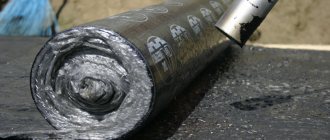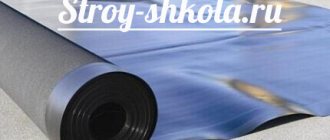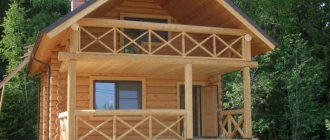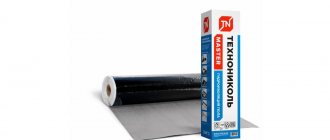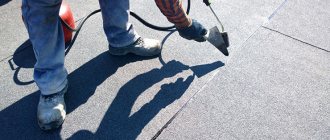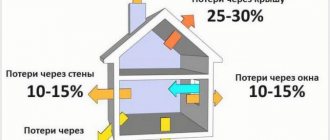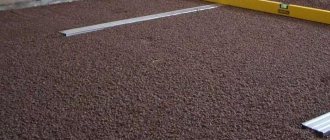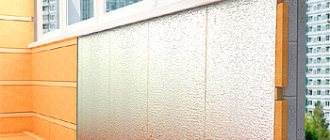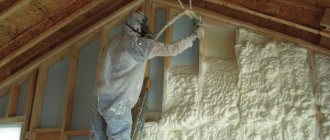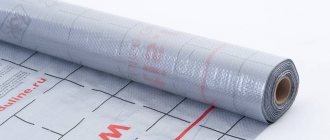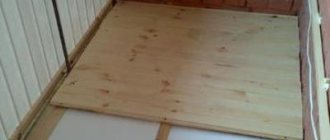The procedure for laying insulating coatings is an integral part of the construction of a high-quality and durable building. Whatever material the floor is made of, it must be covered with waterproofing material on top.
Rolled waterproofing for floors
- 5.1 Video - Waterproofing. Types and applications
- 7.1 Primer price
- 8.1 Video - Laying roll waterproofing. In detail
- 10.1 Video - Rolled self-adhesive waterproofing. Features of application
Why is insulation needed?
Installation of waterproof coatings is relevant not only for private houses and premises located on the ground and first floors, but also for basements, bathrooms, kitchens and storage rooms. High-quality waterproofing performs several important tasks:
- protects the concrete or wooden base from the harmful effects of moisture and temperature changes;
- prevents premature destruction of the foundation;
- helps normalize the level of humidity in the room, reducing the likelihood of the development of mold, fungi and pathogenic microorganisms.
A healthy microclimate is established in a waterproofed room, and there is no threat to human health.
Adhesive waterproofing of wooden floors
Waterproofing methods
The building materials market and the continued interest of developers and manufacturers in this direction provide consumers with a wide range of moisture-proof coatings:
- polymer, polyethylene and anti-condensation films;
- membrane systems;
Membrane waterproofing - waterproofing mastics;
- materials of penetrating and semi-penetrating action;
- insulating resins, cement mixtures and emulsions;
- sprayed polyurea and acrylate compounds;
- liquid applied isolates (liquid rubber);
- rolled materials;
- injection waterproofing agents.
Bipol TechnoNIKOL weld-on roll waterproofing
Constant innovation and development lead to increased demand for progressive coatings with increased service life.
What is roll adhesive waterproofing ↑
In essence, it is a material that prevents the penetration of moisture to the base of the building. It consists of a bitumen-polymer composition, usually applied in several layers to the vertical outer surface of the foundation. Fastening occurs due to the adhesion of molten bitumen to concrete, as well as using a self-adhesive layer of material. This waterproofing is easy to use, has good water resistance and a long service life.
In some cases, adhesive waterproofing is used in conjunction with coating waterproofing: in this case, a special bitumen mastic will serve as an intermediate layer and promote better adhesion of the roll material.
Coating waterproofing applied before pasting is necessary for better adhesion of the rolled material
Material selection
The process of choosing a waterproofing material consists of several aspects that influence the final decision.
- Volume of treated surface. Large coverage areas will require significant (but one-time!) financial investments.
- Working hours. Some insulation materials have a very long drying time, which is not always appropriate for a particular construction project.
- Terms of Use. The waterproofing material must correspond to the climatic conditions of the environment, otherwise dismantling the coating and repeated waterproofing is inevitable.
- Type of building material. Different types of building and structural coatings have their own characteristics that determine the choice of insulation.
Based on financial capabilities, many opt for popular rolled types of waterproofing materials, positioned in terms of durability and affordability.
Roll materials for waterproofing are available to everyone
Price for roll materials for waterproofing
roll waterproofing
Laying features
Modern built-up waterproofing is sold at an affordable price; its installation requires careful adherence to installation rules. The material allows you to organize a new covering or restore an old roofing carpet. As the name suggests, the most important stage of installation is fusing using an open flame. When installing a new coating, waterproofing is applied in two layers; when repairing, one will be enough.
During installation, the built-up waterproofing undergoes flame treatment, which makes it possible to obtain a single, seamless coating.
Roll waterproofing: advantages and disadvantages
The advantages of roll coating include the following:
- high elasticity and the ability of the material to resist stretching, cracks and other deformation;
- ease of installation;
- preservation of properties throughout the entire service life;
- good adhesion and reliable fixation - the coating is suitable for all types of surfaces (concrete, wood, metal);
- minimal drying time; further work on the insulating layer can begin immediately after laying it;
- waste-free installation.
Rolled waterproofing materials
The disadvantages of roll waterproofing are:
- duration of the process;
- the need to attract a significant workforce;
- preliminary preparation of the base;
- sharp and unpleasant odor of the material;
- The optimal air temperature for work is at least +5°C.
The average service life of rolled material applied according to all technological rules is from seven to ten years.
Waterproofing
Characteristics of waterproofing materials ↑
The largest manufacturer of roll waterproofing on the Russian market is the TechnoNikol corporation, so we will consider the technical characteristics of the products of this brand.
Economy class ↑
The components of these materials are selected in such a way as to obtain the cheapest possible product that meets the technical specifications. The service life is more than 5-10 years. A budget option for temporary buildings or non-residential premises, used for roofing work.
Technical characteristics of waterproofing based on cardboard
| Glassine | Ruberoid RPP-300 | Ruberoid RKK-350 | Ruberoid RKP-350 | Rubemast RNA-350 | Rubemast RNP-350 | |
| Weight, kg | 14 | 19,5 | 27 | 24 | 41 | 30 |
| Tensile break, N | 270 | 216 | 313 | 274 | 350 | 350 |
| Water absorption,% | 20 | 2 | 2 | 2 | — | — |
| Heat resistance, deg. | — | 80 | 80 | 80 | 70 | 70 |
| Roll size, m | 1*20 | 1*15 | 1*10 | 1*15 | 1*10 | 1*10 |
| Cover type, top | talc | talc | granulate | asbagal/granulate | talc/dolomite | |
| Cover type, bottom | talc | talc | talc | talc/dolomite | talc/dolomite | |
| Mode of application | free laying or mechanical fixation | glued with mastic or bitumen | welded using a torch | |||
Technical characteristics of waterproofing based on polymer and fiberglass
| Stekloizol | Bikrost | |||||||
| Chamber of Commerce and Industry | HPP | TCH | HKP | EPP | HPP | ECP | TCH | |
| Weight, kg | 25-30 | 35-40 | 45 | 45 | 40 | 40 | ||
| Tensile break, N | 500/400 | 294 | 500/400 | 294 | 343 | 294 | 343 | 700 |
| Heat resistance, deg. | 80 | |||||||
| Roll size, m | 1*9, 1*10, 1*15 | 1*19, 1*10 | 1*15 | 1*15 | 1*10 | 1*10 | ||
| Cover type, top | film | film | shale/granulate | shale/granulate | film | shale/granulate | ||
| Cover type, bottom | film | film | film | film | film | |||
| Mode of application | glued using mastic or melting the bottom layer | |||||||
Rolled waterproofing is heated with a propane torch
Standard class ↑
Materials with optimal price-quality ratio. The service life is 10-15 years.
The range includes the following brands:
- Bipole. Rolled waterproofing materials of this type are suitable for installing roofs with a slight slope and protecting foundations. High adhesive properties allow Bipol to be used on any non-flammable surfaces.
- Bicroelast. Used for steam and waterproofing of various types of roofs. Coarse- and fine-grained powder or polymer film can act as a protective layer. Bicroelast bends well at sub-zero temperatures (down to -10) and has high heat resistance (up to +85).
- Linocrom. A budget option. Suitable for both waterproofing and repair work on the roof. It is recommended to lay the material on a primed concrete or cement-sand base.
- Linocrom REM TKP. A special type of waterproofing roll material that can be laid over old roofing carpet. The service life of the renewed coating is about 10 years.
Important! All listed names can be used in any climatic regions.
Technical characteristics of Uniflex
Business class ↑
Waterproofing roll materials of the business segment are characterized by high precision characteristics and a long service life (10-25 years).
These include:
- Ecoflex. Suitable for protecting roofing and underground structures, recommended for hot regions (does not lose its properties at temperatures up to +130).
- Uniflex. It is used for waterproofing various building structures and arranging roofing pie. Coarse-grained coating protects the surface from ultraviolet rays and extends its service life. Heat resistance – up to +95 degrees.
- Uniflex Vent. “Breathable” roll waterproofing. The coating can be laid on fresh cement screed, damp insulation and old roofing. Due to special channels, the material removes water vapor and prevents the accumulation of condensation. There are no analogues in Russia.
Important! The built-up waterproofing is laid in two rows. Material with the letter K is used as the top layer, with the letter P as the bottom layer.
Technical characteristics of Technoelast Titan
Premium class ↑
High-class waterproofing solves narrowly targeted problems and is installed in difficult areas. The viability period can reach 30 years.
- Technoelast Vent. The material with strip adhesive is intended for the installation of “breathable” roofs. Can be used as a single layer coating. Solves the problem of bloating and air bubbles.
- Technoelast Fix. Does not require preliminary priming of the base. The material is laid loosely on the surface, and the seams are sealed with a propane torch. The sand coating on the bottom of the roll prevents gluing to the base, and the cross-reinforced base prevents the material from deforming.
- Technoelast Solo RP1. Differs in increased fire-fighting characteristics. It is used in places where installation using a fire-free method is required (mechanical fixation, gluing to mastic). Traditional fusion is also possible.
- Technoelast Decor. Rolled waterproofing material with tinted coating. Suitable for roofs with any slope (including hipped ones). Available in four colors: blue, green, red, brown.
- Technoelast Prime. Another variety for fire-free installation. Used in a two-layer roofing system with mastic sizing.
- Technoelast S. Self-adhesive roll waterproofing on a polyester basis. A universal option - can be used on flammable substrates and in confined spaces. Does not require additional equipment.
- Technoelast Flame Stop. The bitumen impregnation contains fire retardants, which provides increased fire protection characteristics. The material is used in the top layer of the roofing pie.
- Technoelast Green. Designed for the installation of green roofs, it is resistant to mechanical damage (contact with plant roots).
- Technoelast Titan. Products in this line are used in both single- and double-layer roofing structures. Fastened mechanically and/or by fusing.
- Technoelast Thermo. These roll materials are intended for waterproofing building structures with increased reliability requirements: roofs, foundations, tunnels, bridges. Technoelast Thermo retains plasticity at high temperatures (up to +130 degrees).
- Technoelast. A universal bioresistant line for the protection of structures and roofing.
Important! Each of the listed lines has several product names. It is better to entrust the selection of suitable material to a specialist.
The technology for installing rolled waterproofing materials is not complicated. However, the installation of each type of coating has its own nuances. If you do not have professional skills, it is better to turn to a team of roofers.
Laying options
Among the rolled waterproofing materials, the following types are distinguished:
- lining (bitumen-polymer, polymer and polyester) materials that do not require the use of adhesives;
- film coatings glued to the primed base with special mastics and adhesives;
- weldable materials based on mastic.
Fusing waterproofing
Depending on the chosen coating, the method of performing the work may be one of the following:
- flooring (used mainly on wooden bases);
Waterproofing flooring - gluing (universal installation method);
- fusing (ideal for concrete floors).
Some installation methods require compliance with safety measures, fire regulations and constant ventilation of the work area. Craftsmen recommend carrying out installation work in dry, warm and windless weather.
Video - Waterproofing. Types and applications
Types of built-up waterproofing
This kind of insulation is a material made from several layers of polymer, bitumen or bitumen-containing compounds applied to a base.
Fused waterproofing impregnated with pure bitumen is the most short-lived. It quickly collapses under the influence of ultraviolet radiation and temperature changes. Bitumen becomes brittle, loses elasticity, and crumbles.
Bitumen-polymer materials for waterproofing are free from such disadvantages. In them, bitumen is modified with polymer additives, which make it possible to maintain the strength and elasticity of the coating under the influence of adverse factors.
For polymeric materials, thermoplastics and vulcanized rubber are used. They are particularly resistant to chemically aggressive substances, ultraviolet radiation and climatic factors. They are distinguished by their technological effectiveness in arranging a moisture-protective layer and durability.
The materials are produced in the form of rolled weld-on waterproofing, consisting of a sequence of layers:
- lower protective;
- bitumen, bitumen-polymer or polymer binder;
- fabric base;
- bitumen, bitumen-polymer or polymer binder;
- top protective layer.
The basis of waterproofing can be fabric made of fiberglass or polyester fiber.
Fiberglass-based fabric is available in two versions: woven and non-woven. The woven version is called fiberglass, the non-woven version is called fiberglass. Fiberglass material is inexpensive, but it is characterized by increased tensile strength. Its disadvantages include extremely low elasticity.
Polyester (polyester) fabrics are non-woven materials. They have high tensile strength and good elasticity, but the price of polyester fabric is much higher than fiberglass.
Stage 1. Surface preparation
If there is any old covering on the floor, then it must be completely dismantled, if possible, down to the concrete base, and the protruding parts of the reinforcement and protrusions must be cut off with a grinder. This is done in order to improve the quality of waterproofing and reduce the risk of detachment of the insulating coating. All dust and debris must be swept away or the surface treated with a special construction vacuum cleaner, preparing the floor for sealing cracks.
Dismantling works
Deep cracks in the concrete base must be opened and thoroughly cleaned. After that, fill all the recesses, cracks and joints with cement mortar (1 part sand to 3 parts cement). If it is necessary to work over deep cracks, you need to use a reinforcing mesh, which will be placed between two layers of cement mortar. If pieces of concrete break off during the process, they must be removed and the unevenness must also be repaired with a building mixture. The treated floor must be dried for 24 hours and then sanded with coarse sandpaper.
Repairing cracks with mortar
Please note that especially deep cracks are filled with a mixture consisting of sand and liquid glass, sometimes with an admixture of fine gravel.
If the floor is wooden, it must be carefully inspected; the boards should not “play” or sag. If necessary, they need to be tightly fixed, partially replaced or completely repaired. It is not advisable to lay waterproofing coatings on sheets of cardboard or plywood, since they are short-lived.
Wooden floor repair. Strengthening floorboards
Along the entire perimeter of the base, a “fillet” is made with the same cement mortar that was used to seal the cracks, and the junctions between the walls and the floor are rounded off. This will protect the material from kinks when placing it on the wall during the process of laying the panels.
: 1 – seam to a depth of 5 mm and a width of 5 mm; 2 – priming; 3 – fillet in the area where the wall adjoins
Bathroom waterproofing
To ensure comprehensive protection against moisture, comprehensive measures should be taken in the bathroom. The places where the ceilings intersect with risers and water supply lines must be filled with liquid waterproofing. Then treat the perimeter of the room with bitumen mastic and reinforce it with PVC tape.
The floor surface is coated with a special mastic or paste. During the drying period, it is necessary to prevent dust or dirt from coming into contact with the material. This procedure is necessary to level the surface. After this, roll waterproofing is laid with 5-7 cm overhangs on the walls. The sheets should overlap each other by 10-15 cm to create a continuous waterproof sheet. The allowances are treated with mastic and fixed on the walls, pressing with a board. At the end, additional bitumen treatment should be performed. Upon completion of waterproofing work, the floor is covered with a decorative coating.
If you plan to have a heated floor in the bathroom, then you need to choose waterproofing with a thermo-reflective layer, if it is of the film type. Cement-polymer mixtures and filling with a continuous waterproof layer are also used. The last method is considered the most reliable of the above.
There are a large number of companies on the market, both domestic and foreign. The leader among Russian manufacturers and suppliers of floor waterproofing is TechnoNIKOL. This company provides a wide range of products and is able to satisfy any requirements. Which manufacturer's product to choose is up to everyone to decide for themselves.
Stage 2. Primer
| Name, weight | Description | Drying time | Consumption kg/m2 | Price |
| Acrylic universal primer, 10 l | Suitable for concrete, cement-sand and gypsum bases; strengthens the surface layer, reduces diffusion capacity | 1 hour | 10 | 151 rub. |
| Soil BOLARS Betonkontakt, 12 kg | Suitable for concrete, stone, plastered surfaces, increases adhesion | 15 o'clock | 0,3 | 712 rub. |
| Primer for absorbent substrates CT17, 5 kg | Suitable for concrete and cement-sand screeds, has antifungal properties and elasticity | 4 hours | 0,2 | 251 rub. |
| Axton concrete contact, 18 kg | For treating smooth concrete substrates, increases adhesion | 2 hours | 0,25-0,3 | 788 rub. |
| Adhesive primer GLIMS BetoContact, 4 kg | For processing smooth concrete substrates, floor tiles | 24 hours | 0,3 | 272 rub. |
Before starting priming, the surface is inspected using a level, taking into account that the maximum allowable clearance between the floor and the device is 4-5 mm.
Apply primer to the floors
The cleaned floor is primed twice, and the drying time of the first layer is at least 3-4 hours. After applying the second layer of primer, the room must be dried for 12 hours, avoiding drafts and temperature changes. After that, a layer of coating waterproofing or other moisture-resistant composition is applied over the entire “fillet”; if desired, you can glue a rubber waterproof tape on a self-adhesive base.
Primer price
primer
Applying a layer of coating waterproofing
Applying waterproofing tape
How to store roll material
To ensure that deposited coatings do not lose their moisture-proof properties, they should be stored under the following conditions:
- install rolls vertically;
- avoid exposure to ultraviolet rays;
- avoid heat sources;
- do not allow moisture to enter.
Rolls must be transported in vehicles with a closed body. Their transportation is possible both in horizontal and vertical positions. If the rolls are laid horizontally, no more than 5 layers are allowed, if vertically - no more than 2 layers.
Stage 3. Preparation of the insulating coating
If a sticky-based coating is used as a waterproofing material, then it must be brought into the room in which the work will be carried out and left for a day.
Other types of waterproofing need to be unrolled along their length and the panels should be left in this state for 24 hours. If the area of the room is too small, then before starting work you simply need to roll the material onto the other side or cut it into pieces of the required length. The resulting blanks should be wiped with solar oil to increase the elasticity of the material and remove excess industrial mineral sand, which will help avoid swelling during installation or pasting.
Video - Laying roll waterproofing. In detail
Classification of roll insulation
Modern manufacturers provide a wide selection of roll waterproofing, which differ in material and method of fixation.
Raw materials may have different coating widths. When choosing raw materials, it is necessary to decide in advance on the intended purpose of the protection, on what material and area it will be installed. Classification by surface material:
1. Polymer membrane waterproofing is based on reinforced polyethylene. There are also options for mastic. Often used when constructing roofing bases. The material creates reliable vapor and waterproofing of surfaces. 2. Bitumen water insulation Divided into subtypes according to the material of the base component: - cardboard; - fiberglass; - based on polyester sheet.
Used for laying floors, foundations, roofs, and walls. Each of the materials has its own nuances of use and advantages.
Classification by installation method:
— Self-adhesive guided waterproofing Self-adhesive rolls have an adhesive part at the bottom. When installing, it is necessary to heat the substance and then fix it to the surface. The base is initially cleaned and prepared in accordance with accepted norms and standards. The device requires certain skills and knowledge. — Mechanical method In this case, a construction gun is used. If there is a need for this, the joint areas are sealed with a special profile strip. — Bitumen guided roll hydroprotection adheres well and almost instantly to different surfaces. The device uses a gas burner to heat the surface of the raw material, which ensures a tight and high-quality fit to the base.
Stage 4. Installation of waterproofing coating
Work begins with chalking the starting markings, according to the chosen direction of the stripes.
Important! All rolled materials are overlapped by at least 5 cm, but the recommended “smell” is 20-25 cm.
If the material is laid as a flooring, then special fastening screws are used, or the covering is not fixed to the floor at all. It is important to remember that the flooring is made on a floor that has been dried to a moisture content of 4-5%.
| Flooring | Permissible percentage of residual humidity for floors without heating | Permissible percentage of residual humidity for heated floors |
| Laminate, parquet, parquet board | Up to 2% | Up to 1.5% |
| Plastic panels, linoleum | Up to 3.4% | Up to 1.5% |
| Carpet on a moisture-proof basis | Until 3% | Up to 1.5% |
| Jute backed carpet | Up to 2.5% | Up to 1.5% |
When gluing waterproofing coatings to the floor, adhesive mixtures and mastics on a polymer-bitumen basis are used, although most often the sticky layer is already applied to one of the surfaces of the insulate, which significantly reduces the work time. If the manufacturer does not provide an adhesive layer on the coating, then the required area of the floor and the edges of the panel are treated with mastic heated to a temperature 20-25 °C higher than the room temperature, after which the material is laid on the base and rolled out with pressure rollers. The joints of adjacent strips are additionally glued with mastic.
Ruberoid is the most common waterproofing option
When laying panels using the fusing method, you should try to maintain a burner flame temperature of about 145-160 °C, which ensures optimal adhesion of the coating to the base. Deviation from the recommended range by even a few degrees can subsequently lead to detachment. When installing the covering using a gas burner, the unrolled material and the floor are gradually heated, and the canvas itself is fixed to the floor. Upon completion of installation, the joints are heated with a burner and pressed to the base.
Fusing waterproofing
The waterproofing is rolled out along the “circle”, extending 5-7 cm onto the wall.
If during rolling the roll “goes to the side”, forming waves, then it needs to be cut and, having aligned the direction, continue working with an interception of 25 cm along the cutting line.
Experts recommend rolling out at least two layers of waterproofing coating on the floor, preferably changing the direction of placement of the sheets (one layer perpendicular to the other), waiting for the previous one to be completely fixed.
Installation of waterproofing
Installation of waterproofing
Self-adhesive waterproofing with a sticky base should remain in the room for a day before starting work. Other types of materials must be unrolled and left for 24 hours to remove severe creases. To make the waterproofing more elastic, it is wiped with solar oil.
Before laying, it is necessary to mark the location of future strips. It must be taken into account that the edges should overlap each other by 20-25 cm. When the waterproofing does not have a self-adhesive coating, it is laid with flooring. To fix the material, use special screws. In some cases, fixation is not necessary. Regardless of whether a wooden or concrete floor is waterproofed, its humidity should be no more than 5%.
For gluing waterproofing, special mastics or glue are used. They are preheated to a temperature of +25°C and applied to the surface of the floor and panels. Then they are pressed to the base and rolled out with special rollers. The edges of the waterproofing, which overlap the previous layer, are additionally coated with mastic for better adhesion. This is especially true for bathroom floors, where the humidity level is constantly high.
When fusing, use a burner whose flame temperature is maintained in the range of +140…+160°C. At lower rates, material may peel off from the floor surface. When laying waterproofing, both surfaces are heated, and then the panel is pressed tightly with a roller. The joints are also heated and tightly fixed. This installation method is unacceptable for wooden floors.
The canvas should extend 6-7 cm onto the wall to ensure high-quality waterproofing. If the roll is deformed and twisted, it is cut, straightened and laying continues. In this case, you should step back 20-25 cm to create an overlap. Experts recommend laying 2-3 layers of waterproofing, placing them perpendicular to each other. If air bubbles form on the surface of the material during installation, they are carefully cut and covered with mastic.
Stage 5. Removing defects
Removing defects
Air bubbles formed during work, after hardening of the material, must be carefully opened with a construction knife and the air released. Then cover the coating cut with heated mastic, carefully pressing the area with a roller to the base.
Pasted and built-up roll waterproofing can be damaged when heavy objects fall on it, so immediately after hardening you can begin laying the concrete screed. The mechanism for laying a waterproofing coating may vary slightly depending on the purpose of the room and further types of work. For example, preliminary waterproofing under “warm” floors and preparing the premises for baths and saunas have several nuances.
